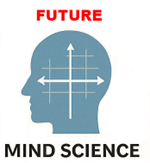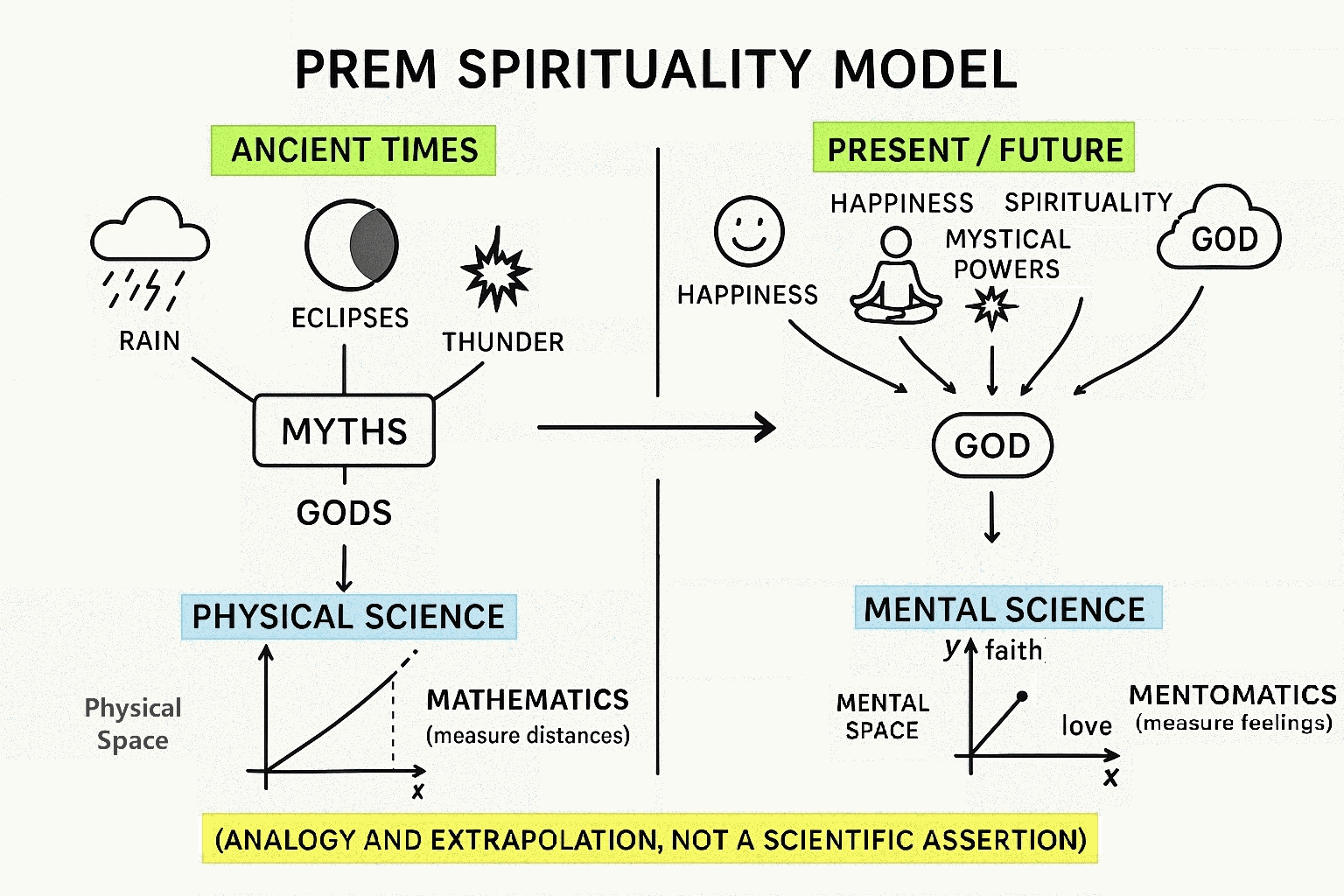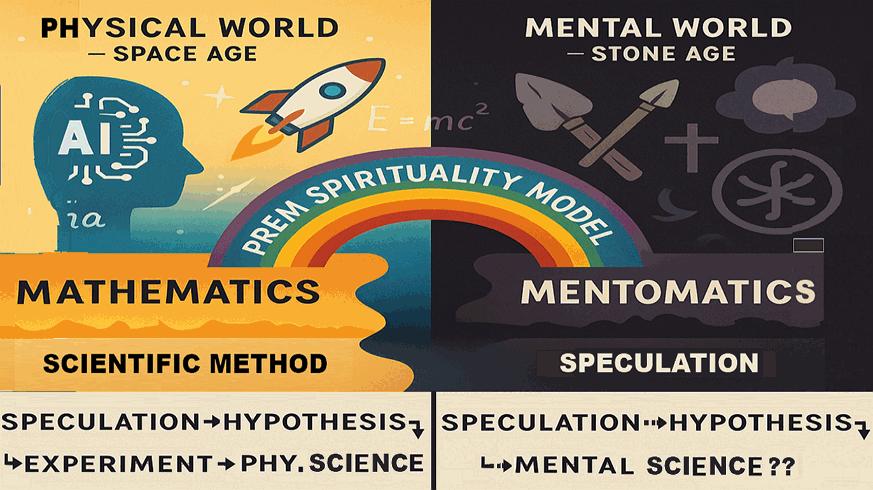| Copyright © 2025 Prem Kamble |
| A Vision, Not a Verdict: Why My Prem Spirituality Model Isn't a Scientific Claim |
| Related Articles |
|
IntroductionResources to know more about Prem Spirituality ModelPrem Spirituality ModelGod in Two Minutes – A Summary God in Two Minutes (Full Book) Spirituality Simplified – A Podcast Transcript of the Podcast
The Prem Spirituality Model is not a scientific theory; it is a philosophical thought experiment, a vision of a future where Mind Science redefines spirituality and the world inside our mind, just as physical science reshaped our understanding of the external physical world. The purpose of the model is not to prove facts but to reduce fanaticism and violence in our world by questioning our beliefs, which may be myths. This add-on to my original work addresses the misunderstanding of the model's intent. It is not about proving god is a myth but suggesting it is only a belief, urging us to question why we fight over beliefs. It relies on the past history of science where several staunch beliefs which led to hatred and violence have met the dust through scientific discoveries. By exploring the psychology of fanaticism and drawing on historical trends, I aim to loosen rigid convictions, fostering a world where humility replaces hostility. While my book acknowledges that science has gradually debunked many long-held beliefs, it also highlights a crucial distinction. Most of these disproven beliefs pertain to physical phenomena in the external, material world that were once attributed to divine intervention. However, But there is yet another world that we live in, and it has been untouched by science - the inner world of our mind, or the mental world. The beliefs which persist and continue to be explained using god even after the rise of science relate to our mental world. The reason is clear: while science has made tremendous strides in understanding and explaining the physical universe, it has struggled - and largely failed - in the mental world. This book rests on the conviction that what we now need is a new science of the mind—a mental science— that could bridge this gap. Yet, since such a science does not yet exist and remains a vision of the future, the hypotheses based on it cannot yet be empirically proven. It is based on principles that await discovery by a future science. Why the Criticism Misses the Point Science enthusiasts often ask, "Where's the proof?" expecting the Prem Spirituality Model to follow the scientific method, with testable hypotheses and data. This expectation misunderstands the model's purpose. I am not claiming spirituality is currently scientific or offering proven facts. Instead, I am proposing a vision - a speculative analogy - that draws on the history of physical science to imagine a future Mind Science. The model isn't a fire of certainty; it is a spark of possibility, asking, "What if spirituality is a mind power, not divine?" This question doesn't need proof to serve its purpose: to inspire doubt and reduce the fanaticism that fuels violence.
Science enthusiasts often ask, "Where's the proof?" expecting the Prem Spirituality Model to follow the scientific method, with testable hypotheses and data. This expectation misunderstands the model's purpose. I am not claiming spirituality is currently scientific or offering proven facts. Instead, I am proposing a vision - a speculative analogy - that draws on the history of physical science to imagine a future Mind Science. The model isn't a fire of certainty; it is a spark of possibility, asking, "What if spirituality is a mind power, not divine?" This question doesn't need proof to serve its purpose: to inspire doubt and reduce the fanaticism that fuels violence.
The critique that I am "force-fitting" spirituality into a scientific framework is a misinterpretation. I am not applying a scientific mould but using an analogy: just as physical science debunked myths like the flat Earth or god-driven eclipses, a new future mental science could demystify spirituality. This is a philosophical exercise, not a scientific claim, designed to provoke reflection, not provide evidence. Not Science, but AnalogyThe Prem Spirituality Model uses the history of physical science as an analogy, not a blueprint. Centuries ago, physical phenomena such as - rain, eclipses, thunder, etc - were attributed to gods. Science, armed with mathematics, revealed natural laws, making those myths obsolete. Today, mental phenomena - happiness, spirituality, mystical powers, the so-called super human powers, the "god zone" (an elevated state of mind marked by bliss and insight) - are still explained by god, an easy recourse for everything unexplained. I have proposed a future Mind Science that, with a new language like Mentomatics, could measure feelings like faith and love, just as mathematics measures distance, rendering god and religion unnecessary. Just as measuring distances opened the floodgates to the development of physical science and mathematics using a simple representation as a cartesian space (with distances as its coordinates), measuring feelings can open up the doors to the concept of a mental space with feelings as its coordinates. This isn't a scientific assertion; it is an extrapolation based on a clear trend in the history of physical science: science explains, myths fade and so do god-based explanations.
The analogy draws a contrast between the external physical world we inhabit and the inner world of the mind - the mental world. As highlighted earlier, we simultaneously live in two vastly different worlds: a space-age physical world of artificial intelligence and starships, and a stone-age mental world still mired in dogma and division. While science has illuminated the physical universe with well-defined laws and principles, the mental world remains shrouded in mystery. Just as potential energy governs physical systems, could there be an analogous mental energy deciding our mental state and driving our success and failure? Science has propelled humanity from the stone age to the age of artificial intelligence and interplanetary exploration - but only in the external world. our understanding of the mind remains primitive. This raises a critical question: Do we now need a new "mental science" - and perhaps a new language, called Mentomatics™, akin to mathematics - to lead us out of the stone age of the mind The model compares physical space (x, y, z axes) to mental space (faith, hope, love axes) to make this possibility vivid. It is a rhetorical tool, not a claim of scientific equivalence. Critics who see this as "force-fitting" miss the point: I am drawing a parallel, not asserting facts. If physical science transformed our understanding of the physical world, why can't a mental science do the same for the world of our minds? The Prem Spirituality Model imagines a future where the mental world catches up. Philosophical Model, Not Scientific Science demands proof, but philosophy dares to dream. The Prem Spirituality Model is a philosophical thought experiment, akin to Bertrand Russell's teapot orbiting the sun or Democritus' (460-370B. C.) atoms imagined centuries before microscopes. These ideas lacked proof at the time, yet they inspired science. Aristarchus of Samos (310–230 BC) proposed a heliocentric model, an "alternative hypothesis" without empirical evidence, later validated by Copernicus and Galileo. These thinkers were philosophers, not scientists, using logic and imagination to challenge assumptions. They laid the foundation of scientific discoveries centuries later. My model follows their path, asking, "What if spirituality is a mind power, not divine?" It is a question, not a conclusion, meant to loosen blind faith. A day will come when people will say, 'Centuries ago, there was a man named Prem Kamble - a visionary who saw the future.'
Science demands proof, but philosophy dares to dream. The Prem Spirituality Model is a philosophical thought experiment, akin to Bertrand Russell's teapot orbiting the sun or Democritus' (460-370B. C.) atoms imagined centuries before microscopes. These ideas lacked proof at the time, yet they inspired science. Aristarchus of Samos (310–230 BC) proposed a heliocentric model, an "alternative hypothesis" without empirical evidence, later validated by Copernicus and Galileo. These thinkers were philosophers, not scientists, using logic and imagination to challenge assumptions. They laid the foundation of scientific discoveries centuries later. My model follows their path, asking, "What if spirituality is a mind power, not divine?" It is a question, not a conclusion, meant to loosen blind faith. A day will come when people will say, 'Centuries ago, there was a man named Prem Kamble - a visionary who saw the future.'
History shows that science often begins with speculative ideas. Democritus imagined atoms by reasoning, not experimenting, picturing a seashell divided until indivisible bits remained. Copernicus envisioned a sun-centered universe without telescopes. Galileo faced scorn for supporting it, yet their "unscientific" ideas sparked revolutions. Today, we laugh at flat-Earth believers, but how is their belief different from our own about god. The Prem Spirituality Model is a precursor to future research, not a finished science, inviting exploration, not certainty. It is the first step to an unimaginable future.
The Psychology of Fanaticism: Loosening Blind Faith The real objective of the Prem Spirituality Model is to counter the psychology of fanaticism. Fanaticism thrives on absolute certainty - a blind, 100% belief. Fanatics act - often violently - because their beliefs are carved in stone. But even a small crack, a 10% doubt that they could be wrong, can weaken the foundations of extremism. And change their behaviour dramatically. Picture a ship sailing toward a cliff, its captain certain the course is divine. A 10-degree turn seems minor, but it steers the ship to safety, a 180-degree change in outcome. Similarly, a fanatic who pauses to think, "I might be wrong," may choose dialogue over destruction, tolerance over terror.
The real objective of the Prem Spirituality Model is to counter the psychology of fanaticism. Fanaticism thrives on absolute certainty - a blind, 100% belief. Fanatics act - often violently - because their beliefs are carved in stone. But even a small crack, a 10% doubt that they could be wrong, can weaken the foundations of extremism. And change their behaviour dramatically. Picture a ship sailing toward a cliff, its captain certain the course is divine. A 10-degree turn seems minor, but it steers the ship to safety, a 180-degree change in outcome. Similarly, a fanatic who pauses to think, "I might be wrong," may choose dialogue over destruction, tolerance over terror.
This crack doesn't require shattering faith. A small doubt can stop a cycle of hate. Imagine if, in Galileo's time, his accusers had entertained just a 10% chance that space travel might one day be real, or could imagine a future with telescopes proving the Earth's motion - it could have softened their dogma and Galileo would be spared of the torture. Today, we are the fanatics, fighting over gods we may have invented. Likewise, today, if we allow ourselves to imagine a science of the mind with that same openness and humility, we might begin to reduce the grip of fanaticism and violence. This model stands as a bridge between skepticism and imagination. It asks the average believer to question, the fanatic to pause and reflect, and the skeptic to dare to dream. The model suggests spirituality could be a mind power, not divine, creating that crack: "What if my belief is a myth?" This question, inspired by the history of debunked beliefs (flat Earth, geocentric skies), aims to weaken fanaticism, not disprove faith. My model encourages intellectual humility. It invites us to replace the arrogance of "I am right" with the honesty of "I don't know". The ancients, rather than turning their theories into dogmas, could have said: "We don't know yet; perhaps future science will explain it." Time Swing Analysis: Cracking the Stone of Fanaticism The Prem Spirituality Model does not aim to prove that God is a myth - it merely suggests the possibility, so we question why we fight and kill over something that might not even be real. If God and religion are myths, then our wars are no more rational than ancient tribes battling over whose deity commands thunder.
The Prem Spirituality Model does not aim to prove that God is a myth - it merely suggests the possibility, so we question why we fight and kill over something that might not even be real. If God and religion are myths, then our wars are no more rational than ancient tribes battling over whose deity commands thunder.
This model employs a concept called Time Swing Analysis to bring future possibilities into present awareness so as to make them a bit tangible. By mentally swinging back into the past, we revisit how unshakable ancient beliefs once were - (beliefs we now find absurd, such as a flat Earth or the idea that lightning is divine wrath), and how today's science (round Earth, instant messages) would've seemed impossible then. Then, by swinging forward into the future, we imagine the birth of a new Mind Science unravelling the laws of the inner world and the mind's mysteries, rendering god obsolete. Swinging back to the present, we confront a humbling realization: just as we ridicule the superstitions of the past, future generations may ridicule us. They might look back and say, "There once lived barbarians who shed blood over fairy tales." Even those who consider themselves moderate or rational believers may be seen as fanatics - just as we now see all flat-Earthers as primitive, regardless of their intent. Time Swing exercise helps us realise that if ancient tribes had to imagine the unimaginable to foresee today's scientific world, we too must stretch our imagination and think the unthinkable to envision tomorrow's. It requires a leap - not into blind belief, but into open-minded exploration. Let go of rigid skepticism that says, "It's 100% impossible." Instead, leave space for a 10% possibility - for that sliver of "what if?" is where progress begins. Time Swing Analysis reinforces this vision. Consider past impossibilities: a medieval scribe couldn't dream of WhatsApp, nor a cart driver of jets. Yet these became reality. If measuring light was once unthinkable, why dismiss measuring love or faith? The model makes an unimaginable future slightly more real, not by proving it but by showing the pattern: the unthinkable becomes possible. In the physical world, we're in the space age; in the mental world, we're in the stone age. A new science - Mind Science - could bridge that gap. Prem Spirituality Model vs. Russell's Teapot: A Reasoned VisionBertrand Russell's teapot analogy - a playful thought experiment imagining an unverifiable teapot orbiting the sun - was a provocative jab at religious dogma. Its deliberate absurdity aimed to expose the folly of believing in unprovable deities, challenging blind faith with wit. While brilliant for sparking debate, its exaggerated premise lacks grounding in evidence or trends, serving as a rhetorical tool rather than a constructive hypothesis. The Prem Spirituality Model, in contrast, offers a more reasoned vision, rooted in historical patterns and forward-looking possibility, designed not to mock but to inspire hope and reduce division.Unlike Russell's teapot, which floats in speculative isolation, my model draws on the history of physical science - how mathematics debunked myths like flat Earth or god-driven eclipses - to propose a parallel future for mental science. This isn't a scientific claim but a philosophical hypothesis, grounded in the trend of science unveiling truths once deemed divine. Russell's teapot rightly questions unproven beliefs, but my model goes further, asking, "What if spirituality is a mind power, not divine?" This question aims to crack the stone of fanaticism, fostering humility to end religious violence. While Russell's analogy provokes, Prem Spirituality Model tries to change mindsets by envisioning a beautiful unified world, where spiritual laws shine like gravity, free of myths. It's not about proof - it's about daring to imagine a future where we say, "I might be wrong," and build peace together. Future Science: No Proof Yet, and That's the Point Skeptics are right - there's no proof for Mind Science, because the science doesn't exist yet. Expecting evidence for a future science is like asking a caveman to demonstrate Wi-Fi before fire. The Prem Spirituality Model isn't applying a scientific framework; it is a speculative vision inspired by historical trends. Science begins with wild ideas, and mine is no different. By envisioning a future where Mentomatics charts the mind like mathematics charts the world, I am not proving it - I am inviting you to consider it.
Skeptics are right - there's no proof for Mind Science, because the science doesn't exist yet. Expecting evidence for a future science is like asking a caveman to demonstrate Wi-Fi before fire. The Prem Spirituality Model isn't applying a scientific framework; it is a speculative vision inspired by historical trends. Science begins with wild ideas, and mine is no different. By envisioning a future where Mentomatics charts the mind like mathematics charts the world, I am not proving it - I am inviting you to consider it.
To those who call this unscientific, I say: science isn't just data; it is curiosity. The Scientific Method holds that our best model is temporary, open to improvement as new evidence emerges. By dismissing this vision as "not possible," skeptics risk the rigidity that tormented Galileo, contradicting the method's spirit of exploration. If Aristarchus' heliocentric hypothesis was dismissed for lack of proof, we would still think the Earth is flat. Not Exploring is UnscientificDismissing the Prem Spirituality Model as "unscientific" reflects a narrow view of science's history, which began with "unscientific" ideas. Science is curiosity, exploration, and the courage to think the unthinkable. By rejecting this vision, skeptics mirror the dogma of Galileo's tormentors, who refused to consider a moving Earth. The model is a spark, not a fire, planting a seed of doubt to reduce acts of violence. If it inspires a few fanatics to hesitate, believers to reflect, or skeptics to imagine, it has served its purpose.
Let's not demand proof for tomorrow's science; let's dare to dream it today. The Prem Spirituality Model invites you to crack the stone of certainty, to say, "I might be wrong," and to envision a world united, not divided by myths. That's not dogma - it is hope.
Write to Me | Related Articles | Top
Copyright © 2025 Prem Kamble
Go Back | Go Top |



